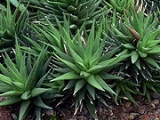
Haworthia
Encyclopedia
Haworthia is a genus of flowering plants within the family Xanthorrhoeaceae
, subfamily Asphodeloideae.. They are small (typically 20 cm high) solitary or clump-forming and endemic to South Africa
. Some species have firm, tough leaves, usually dark green in color, whereas other are soft and semi-translucent. Their flowers are small, white and very similar between species. But their leaves show wide variations even within one species.
The classification of the flowering plant subfamily Asphodeloideae is weak and concepts of the genera are not well substantiated. Haworthia is similarly a weakly contrived genus consisting of three distinct groups: sub-genera Haworthia, Hexangularis, and Robustipedunculares. Related genera are Aloe
, Gasteria
and Astroloba and intergeneric hybrids are known.
The genus Haworthia is named after the botanist Adrian Hardy Haworth
. Bayer recognizes approximately 61 species whereas other taxonomists are very much less conservative (1999, Haworthia Revisited, Umdaus Press). The species are endemic to South Africa, Swaziland, Namibia and Maputoland. The plants are small, forming rosettes of leaves from 30mm to exceptionally 300mm in diameter. These rosettes are usually stemless but in some species stems reach up to 500mm.
Their flowers are small, white and very similar between species. There are differences in the flowers of the three sub-genera that botanists have curiously considered inconsequential although the differences between species in the same subgenus definitely are. The roots, leaves and rosettes do demonstrate some generic differences while wide variations occur even within one species. Because of their horticultural interest, the taxonomy has been dominated by amateur collectors and the literature is rife with misunderstanding of what the taxa actually are or should be.
There is widespread special collector interest but some species such as Haworthia attenuata and Haworthia cymbiformis
, are fairly common house and garden plants. Haworthia species reproduce both through seed and through budding, or offsets. Certain species or clones may be more successful or rapid in offset production, and these pups are easily removed to yield new plants once a substantial root system has developed on the offshoot. Less reliably, the plants may also be propagated through leaf cuttings, and in some instances, through tissue culture.
Xanthorrhoeaceae
Xanthorrhoeaceae is the botanical name of a family of flowering plants in the order Asparagales. Such a family has been recognized by most taxonomists, but the circumscription of the family has varied wildly....
, subfamily Asphodeloideae.. They are small (typically 20 cm high) solitary or clump-forming and endemic to South Africa
South Africa
The Republic of South Africa is a country in southern Africa. Located at the southern tip of Africa, it is divided into nine provinces, with of coastline on the Atlantic and Indian oceans...
. Some species have firm, tough leaves, usually dark green in color, whereas other are soft and semi-translucent. Their flowers are small, white and very similar between species. But their leaves show wide variations even within one species.
The classification of the flowering plant subfamily Asphodeloideae is weak and concepts of the genera are not well substantiated. Haworthia is similarly a weakly contrived genus consisting of three distinct groups: sub-genera Haworthia, Hexangularis, and Robustipedunculares. Related genera are Aloe
Aloe
Aloe , also Aloë, is a genus containing about 500 species of flowering succulent plants. The most common and well known of these is Aloe vera, or "true aloe"....
, Gasteria
Gasteria
Gasteria is a genus of succulent plants native to South Africa. Closely related genera include Aloe and Haworthia. The genus is named for its stomach-shaped flowers and is part of the family Xanthorrhoeaceae, subfamily Asphodeloideae...
and Astroloba and intergeneric hybrids are known.
The genus Haworthia is named after the botanist Adrian Hardy Haworth
Adrian Hardy Haworth
Adrian Hardy Haworth was an English entomologist, botanist and carcinologist.He was the son of Benjamin Haworth of Haworth Hall...
. Bayer recognizes approximately 61 species whereas other taxonomists are very much less conservative (1999, Haworthia Revisited, Umdaus Press). The species are endemic to South Africa, Swaziland, Namibia and Maputoland. The plants are small, forming rosettes of leaves from 30mm to exceptionally 300mm in diameter. These rosettes are usually stemless but in some species stems reach up to 500mm.
Their flowers are small, white and very similar between species. There are differences in the flowers of the three sub-genera that botanists have curiously considered inconsequential although the differences between species in the same subgenus definitely are. The roots, leaves and rosettes do demonstrate some generic differences while wide variations occur even within one species. Because of their horticultural interest, the taxonomy has been dominated by amateur collectors and the literature is rife with misunderstanding of what the taxa actually are or should be.
There is widespread special collector interest but some species such as Haworthia attenuata and Haworthia cymbiformis
Haworthia cymbiformis
Haworthia cymbiformis is a species of the genus Haworthia in the family Asphodelaceae.Plants are small with a rosette. The leaves are thick and light green.The main characteristic of this species is that the ends of the leaves are transparent...
, are fairly common house and garden plants. Haworthia species reproduce both through seed and through budding, or offsets. Certain species or clones may be more successful or rapid in offset production, and these pups are easily removed to yield new plants once a substantial root system has developed on the offshoot. Less reliably, the plants may also be propagated through leaf cuttings, and in some instances, through tissue culture.

